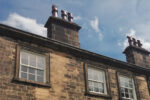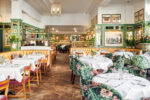What is the Glass Cone of Catcliffe, Rotherham?

By James Barker
Towards the end of the Sheffield Parkway when driving towards the M1 into Rotherham, you may notice a brick cone rising above the trees on the border between Catcliffe and Brinsworth. The cone looks out of place amongst the modern housing and bustling roads, but its unique structure tells the story of its purpose and history.
The cone is affectionately known as the Catcliffe Glass Cone and is a remnant of the expansive glassmaking industry that thrived in Rotherham from the mid-1700s. The cone was built in 1740 by Will Fennely and designed to provide a funnel for smoke to travel through from a large working area that enclosed a furnace in the centre of the structure. It is one of the only surviving examples of this type of cone in the country, and was positioned here due to its proximity to nearby coal mining operations.
From surviving sources it appears two cones were initially constructed on the site, providing a greater capacity for production. The Catcliffe site ceased production in 1884, being dismantled shortly afterwards, except for the one remaining cone structure we see today. The Walker family, well-known industrialists, also had many ties to other industries, including glassmaking at Catcliffe Glass Cone.
“Unearthed”
The earliest examples of glassmaking in Rotherham could be seen in Wentworth during 1631, although this would have been a more simple effort when compared to the industrial processes used in later years at sites such as Catcliffe. Other examples include well-known businesses such as Beatson and Clark and Co., who supplied glass to industries involved in chemical production, cosmetics and pharmaceuticals.
The reach of this company was such that glass bottles have been unearthed in grave sites in the United States of America dating back to the 1800s.
The brass industry in Rotherham is also worth a mention while discussing famous heavy industry in Rotherham. One of the most well-known companies was Guest and Chrimes, where the screw-down tap was first invented in 1845 by Edward Chrimes.
 “Trusted brand”
“Trusted brand”
The company began as a small family business at the beginning of the nineteenth century specialising in plumbing and glazier services. The founder, Edward Chrimes, was born in Bridgegate in 1784 and had gone into partnership with his sons by 1837.
The family business expanded into developing a brass foundry (initially bought for £1,000) located between the marketplace and the River Don, providing a perfect location for transporting goods. With the business doing well, a partnership was formed with John Guest (born in Rotherham in 1799). Both Edward and John were followers of the temperance movement and this was how they had initially met.
The company was rebranded to incorporate both names, and the business was further expanded making it one of the largest companies in Rotherham. Guest and Chrimes became a trusted brand across the country and helped to elevate Rotherham’s status as a manufacturer of good quality goods.
Article taken from ‘A-Z of Rotherham‘ by James Barker, published by Amberley Publishing
Top image: Glass Cone, Catcliffe by Chris Morgan licensed under the Creative Commons Attribution-Share Alike 2.0 Generic license
FAQs – Catcliffe Glass Cone & Rotherham’s Industrial Past
What is the Catcliffe Glass Cone?
A Grade I listed, Scheduled Ancient Monument, the Catcliffe Glass Cone is the oldest surviving glass cone in Western Europe – a brick-built, funnel-shaped structure from the 18th-century glassmaking era.
When was it built and by whom?
It was built in 1740 by William Fenney (also recorded as Will Fenney/Fennely), an experienced glassworks manager connected to Bolsterstone works via his mother-in-law.
Why was Catcliffe chosen as the site?
Partly due to coal being close at hand – vital for firing furnaces – and partly because a family will barred Fenney from setting up within 10 miles of Bolsterstone; Catcliffe sits just beyond that limit.
How does a glass cone work?
It enclosed a central furnace with a tall flue to draw smoke and heat upward, smaller “pot warming” furnaces around the perimeter, and a circular working platform – the shape improved draught and temperature control.
How tall is the cone?
Approximately 20 metres (around 66 ft) high, with arched openings at the base to maximise airflow.
How many glass cones survive in the UK?
Only four survive – Catcliffe, Lemington (Tyne and Wear), Red House Cone at Wordsley (West Midlands) and Alloa (Scotland) – making Catcliffe exceptionally rare.
When did production end at Catcliffe?
The site ceased production in the 1880s – sources cite 1884 to c.1887 – with a brief reopening in 1900 before falling into disuse.
What other roles has the site had?
It served as a First World War prisoner-of-war camp and as a canteen during the 1926 General Strike – a reminder of its adaptable industrial footprint.
Has the cone been at risk?
Yes – demolition was mooted in the 1960s; it gained Grade I listing in 1968. Public access closed in 2006 due to falling bricks, with restoration undertaken in 2014.
How does the cone relate to wider glassmaking in Rotherham?
It represents the shift from small-scale to industrial glassmaking. Rotherham’s sector later included firms like Beatson Clark & Co., whose bottles travelled globally – even being unearthed in 19th-century US grave sites.
What powered the growth of glass cones in Britain?
Coal firing – Britain’s switch from wood to coal encouraged tall, draught-efficient cones that enabled hotter, steadier furnaces for mass production.
What other notable Rotherham industries are linked to this story?
Brass founding at Guest & Chrimes – famed for the screw-down tap patented in 1845 – helped cement Rotherham’s reputation for high-quality engineering alongside glassmaking.
Where is the cone located and what does it look like today?
It stands by the Sheffield Parkway near the M1, on the Catcliffe–Brinsworth border. The striking brick cone still dominates the skyline, a rare survivor of 18th-century industrial architecture.
Why is the Catcliffe Glass Cone important?
It is a unique window into early industrial glassmaking, a landmark of South Yorkshire’s heritage and a touchstone for Rotherham’s broader story of innovation and manufacture.










